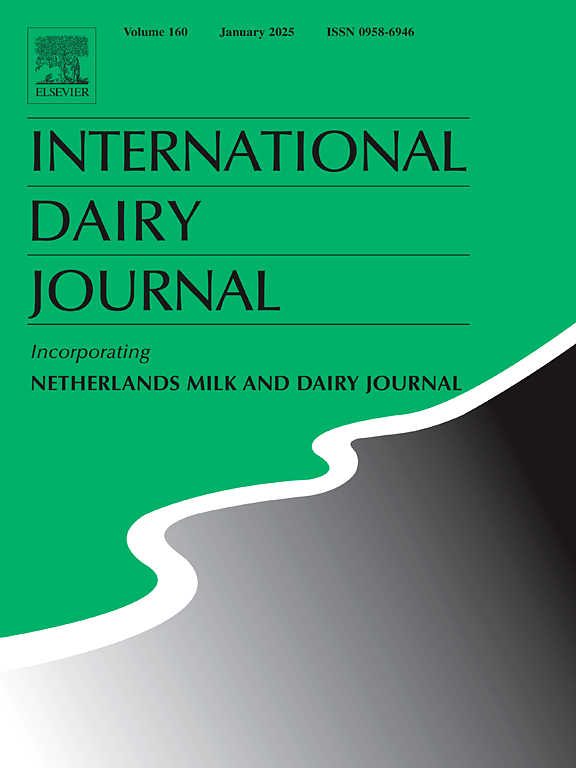益生菌发酵提高了skyr型酸奶的工艺性能和保健潜力
IF 3.1
3区 农林科学
Q2 FOOD SCIENCE & TECHNOLOGY
引用次数: 0
摘要
skyr型酸奶(STY)已成为益生菌和具有健康益处的功能成分的有前途的载体。本研究评估了由嗜酸乳杆菌LA5 (S1)、植物乳酸杆菌299v (S2)和植物乳酸杆菌LPLDL (S3)等益生菌发酵的STY配方的工艺特性和促进健康的潜力,并进行了对照。分析包括近端成分、物理化学和感官特征、益生菌活力、酶活性测定以及免疫调节和抗氧化特性的细胞测试。益生菌发酵保持了STY的高蛋白(5.73-5.88 g/100 g)和低脂(2.31-2.53 g/100 g)特征,同时减少了协同作用(38 - 40%),并增加了黏度,因为增加了胞外多糖的产生。感官评价证实,sti配方保持相当的可接受性,以控制和商业skyr产品。体外消化后,益生菌活力超过7 log菌落形成单位/mL,确保有效输送到肠道。体外消化后,S3对α-淀粉酶的抑制作用最强,S2对α-葡萄糖苷酶的抑制作用较好。S2和S3也表现出最高的胆汁盐水解酶活性,表明潜在的降胆固醇特性。免疫调节作用包括S2和S3使肿瘤坏死因子α (TNF-α)的产生减少32%。此外,S3显示出最大的抗炎活性,减少44%的一氧化氮生成。所有配方均可提高抗炎白介素-10 (IL-10)水平(14-18倍),增强吞噬活性(1.7 - 1.9倍),降低氧化应激(14 - 18%)。这些结果突出了STY配方的潜力,特别是那些用植物乳杆菌299v和LPLDL发酵的配方,作为创新的乳制品功能食品。本文章由计算机程序翻译,如有差异,请以英文原文为准。
Probiotic fermentation enhances the technological properties and health-promoting potential of skyr-type yogurts
Skyr-type yogurt (STY) has emerged as a promising carrier for probiotics and functional components with health benefits. This study evaluated the technological properties and health-promoting potential of STY formulations fermented with probiotics: Lactobacillus acidophilus LA5 (S1), Lactiplantibacillus plantarum 299v (S2), and Lactiplantibacillus plantarum LPLDL (S3), alongside a control. Analyses included proximal composition, physicochemical and sensory profiles, probiotic viability, enzymatic activity assays, and cellular tests for immunomodulatory and antioxidant properties. Probiotic fermentation preserved the moderately high-protein (5.73–5.88 g/100 g) and low-fat (2.31–2.53 g/100 g) profile of STY while reducing syneresis (38–40 %) and enhancing viscosity due to increased exopolysaccharide production. The sensory evaluation confirmed that STY formulations maintained comparable acceptability to the control and a commercial skyr product. Probiotic viability exceeded 7 log colony forming units/mL after in vitro digestion, ensuring effective delivery to the gut. Regarding functional properties, S3 showed the strongest α-amylase inhibition, while S2 excelled in α-glucosidase inhibition after in vitro digestion. Both S2 and S3 also exhibited the highest bile salt hydrolase activity, indicating potential cholesterol-lowering properties. Immunomodulatory effects included a 32 % reduction in tumor necrosis factor alpha (TNF-α) production by S2 and S3. Additionally, S3 demonstrated the greatest anti-inflammatory activity, reducing nitric oxide production by 44 %. All formulations increased anti-inflammatory interleukin-10 (IL-10) levels (14–18-fold), enhanced phagocytic activity (1.7–1.9-fold), and reduced oxidative stress (14–18 %). These results highlight the potential of STY formulations, especially those fermented with L. plantarum 299v and LPLDL, as innovative dairy-based functional foods.
求助全文
通过发布文献求助,成功后即可免费获取论文全文。
去求助
来源期刊

International Dairy Journal
工程技术-食品科技
CiteScore
6.50
自引率
9.70%
发文量
200
审稿时长
49 days
期刊介绍:
The International Dairy Journal publishes significant advancements in dairy science and technology in the form of research articles and critical reviews that are of relevance to the broader international dairy community. Within this scope, research on the science and technology of milk and dairy products and the nutritional and health aspects of dairy foods are included; the journal pays particular attention to applied research and its interface with the dairy industry.
The journal''s coverage includes the following, where directly applicable to dairy science and technology:
• Chemistry and physico-chemical properties of milk constituents
• Microbiology, food safety, enzymology, biotechnology
• Processing and engineering
• Emulsion science, food structure, and texture
• Raw material quality and effect on relevant products
• Flavour and off-flavour development
• Technological functionality and applications of dairy ingredients
• Sensory and consumer sciences
• Nutrition and substantiation of human health implications of milk components or dairy products
International Dairy Journal does not publish papers related to milk production, animal health and other aspects of on-farm milk production unless there is a clear relationship to dairy technology, human health or final product quality.
 求助内容:
求助内容: 应助结果提醒方式:
应助结果提醒方式:


